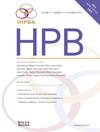International validation of a natural-killer-cell–based model to predict recurrence-free survival in hepatocellular carcinoma
IF 2.4
3区 医学
Q2 GASTROENTEROLOGY & HEPATOLOGY
引用次数: 0
Abstract
Background
Models estimating recurrence-free survival (RFS) after hepatectomy for hepatocellular carcinoma (HCC) rely on clinical variables and often overlook tumor immunobiology. The Liver Immune Status Index (LISI), derived from BMI, albumin, and Fibrosis-4 (FIB-4), reflects liver-resident natural killer (NK) cell activity. We validated the HISCO-HCC score, combining LISI, tumor burden score (TBS), and alpha-fetoprotein (AFP), using an international cohort.
Methods
Patients undergoing curative-intent hepatectomy for HCC (2000–2023) were identified from an international database (median follow-up: 38.9 [14.9–67.5] months). RFS was the primary endpoint. LISI’s predictive performance was compared with other liver-related indices. The original HISCO-HCC (oHISCO-HCC) was recalibrated via multivariable Cox regression in a training cohort (80 %) stratified by region, yielding a modified score (mHISCO-HCC). Validation was conducted in the testing cohort (20 %).
Results
Among 1213 patients, LISI had the highest AUCs among liver-related indices for 1-/2-year RFS (0.60/0.60) and 1-/5-year OS (0.64/0.60). The formula: mHISCO-HCC = 0.49 × TBS + 0.41 × log(AFP) + 0.13 × LISI. In testing, mHISCO-HCC outperformed oHISCO-HCC and mHALT-HCC for 12-/36-/60-month RFS (AUCs: 0.73/0.71/0.66) with the lowest AIC. It also had the highest OS AUCs and stratified RFS and OS (p < 0.001).
Conclusions
The mHISCO-HCC score, integrating tumor morphology, biology, and NK cell-based immunity, improves prediction of recurrence and survival. It may aid postoperative stratification.
基于自然杀伤细胞模型预测肝细胞癌无复发生存期的国际验证。
背景:估计肝细胞癌(HCC)肝切除术后无复发生存期(RFS)的模型依赖于临床变量,往往忽略肿瘤免疫生物学。由BMI、白蛋白和纤维化-4 (FIB-4)得出的肝脏免疫状态指数(LISI)反映了肝脏自然杀伤细胞(NK)的活性。我们使用国际队列验证了HISCO-HCC评分,结合LISI、肿瘤负荷评分(TBS)和甲胎蛋白(AFP)。方法:从国际数据库(中位随访时间:38.9[14.9-67.5]个月)中确定接受治愈性肝切除术的HCC患者(2000-2023)。RFS是主要终点。比较LISI对其他肝脏相关指标的预测效果。在按地区分层的培训队列(80%)中,通过多变量Cox回归重新校准原始的HISCO-HCC (oHISCO-HCC),得到修改后的评分(mHISCO-HCC)。在测试队列(20%)中进行验证。结果:1213例患者中,LISI在1-/2年RFS(0.60/0.60)和1-/5年OS(0.64/0.60)的肝脏相关指标中auc最高。公式:mHISCO-HCC = 0.49 × TBS + 0.41 × log(AFP) + 0.13 × LISI。在测试中,mHISCO-HCC在12个月/36个月/60个月的RFS (auc: 0.73/0.71/0.66)中优于oHISCO-HCC和mhalf - hcc, AIC最低。其OS auc、分层RFS和OS也最高(p < 0.001)。结论:mHISCO-HCC评分综合了肿瘤形态、生物学和NK细胞免疫,提高了复发和生存的预测。它可能有助于术后分层。
本文章由计算机程序翻译,如有差异,请以英文原文为准。
求助全文
约1分钟内获得全文
求助全文
来源期刊

Hpb
GASTROENTEROLOGY & HEPATOLOGY-SURGERY
CiteScore
5.60
自引率
3.40%
发文量
244
审稿时长
57 days
期刊介绍:
HPB is an international forum for clinical, scientific and educational communication.
Twelve issues a year bring the reader leading articles, expert reviews, original articles, images, editorials, and reader correspondence encompassing all aspects of benign and malignant hepatobiliary disease and its management. HPB features relevant aspects of clinical and translational research and practice.
Specific areas of interest include HPB diseases encountered globally by clinical practitioners in this specialist field of gastrointestinal surgery. The journal addresses the challenges faced in the management of cancer involving the liver, biliary system and pancreas. While surgical oncology represents a large part of HPB practice, submission of manuscripts relating to liver and pancreas transplantation, the treatment of benign conditions such as acute and chronic pancreatitis, and those relating to hepatobiliary infection and inflammation are also welcomed. There will be a focus on developing a multidisciplinary approach to diagnosis and treatment with endoscopic and laparoscopic approaches, radiological interventions and surgical techniques being strongly represented. HPB welcomes submission of manuscripts in all these areas and in scientific focused research that has clear clinical relevance to HPB surgical practice.
HPB aims to help its readers - surgeons, physicians, radiologists and basic scientists - to develop their knowledge and practice. HPB will be of interest to specialists involved in the management of hepatobiliary and pancreatic disease however will also inform those working in related fields.
Abstracted and Indexed in:
MEDLINE®
EMBASE
PubMed
Science Citation Index Expanded
Academic Search (EBSCO)
HPB is owned by the International Hepato-Pancreato-Biliary Association (IHPBA) and is also the official Journal of the American Hepato-Pancreato-Biliary Association (AHPBA), the Asian-Pacific Hepato Pancreatic Biliary Association (A-PHPBA) and the European-African Hepato-Pancreatic Biliary Association (E-AHPBA).
 求助内容:
求助内容: 应助结果提醒方式:
应助结果提醒方式:


